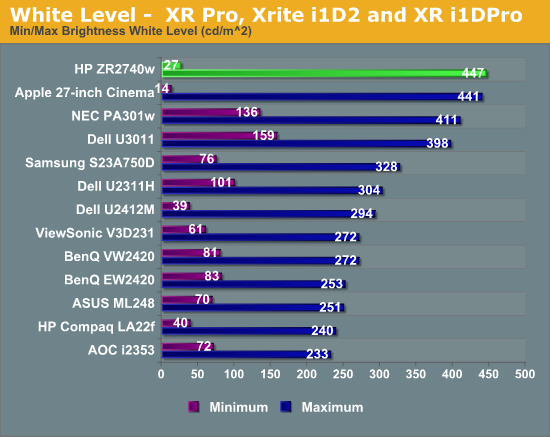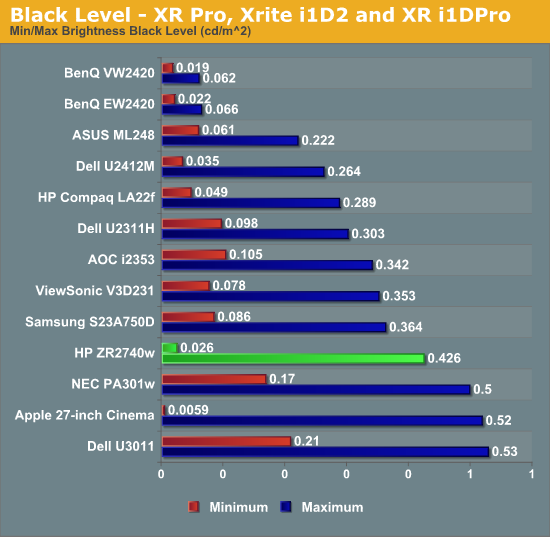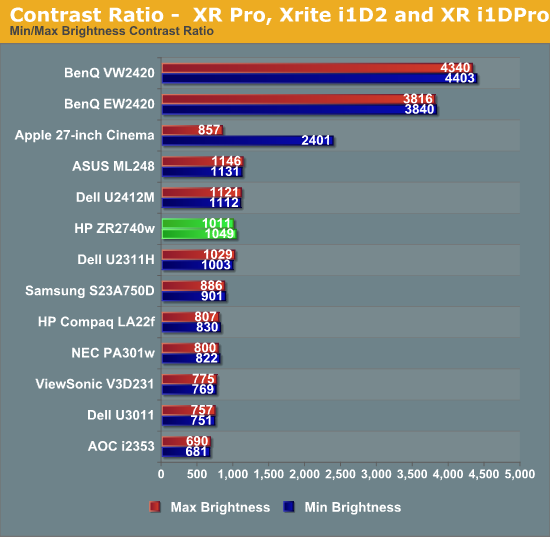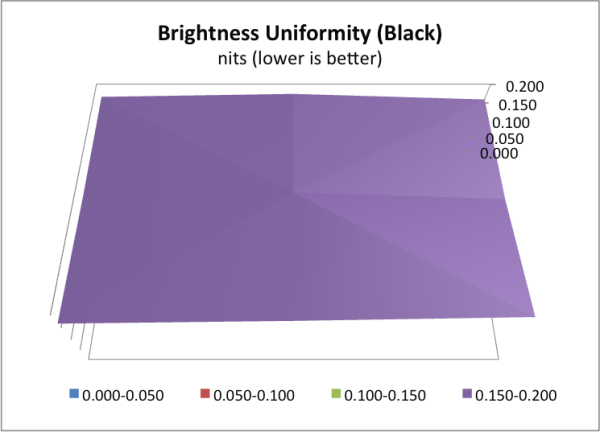HP ZR2740w - High Resolution IPS that Doesn't Break the Bank
by Chris Heinonen on March 16, 2012 1:15 AM ESTBrightness and Contrast
Is your work environment bright? Are there massive spotlights behind you that shine directly onto your screen? Well, don’t worry; the ZR2740w will produce more than enough light for you. I’d expect screens to get a little dimmer as the size gets larger, since a backlight would need to be more powerful and more expensive to light it up, but apparently that is not the case. The HP managed to put out almost 450 nits of brightness when turned up all the way, which is plenty for anyone no matter what their work environment.

I can only assume that to evenly light up a 27” or larger LCD panel, vendors need to use larger, more powerful backlights and it is as easy to use one that does this much brightness as one that only does 250 nits of light, but I’m going to say this is a good thing. The downside to a larger light is that it might cause the black levels to be higher than on other displays, and that does seem to be the case here with the HP.

The black levels on the HP are higher, but they are right in line with other 27” and 30” displays, so it really is a middle of the road result for it. Given the cost difference between the displays, that the HP equals them in performance is very nice to see on here. One area that the larger panels fell behind in was contrast ratio, where they only manage around 750:1 which is a little disappointing given their cost. The HP manages to exceed this, offering over 1,000:1 at both maximum and minimum brightness levels.

The only high resolution display we have tested that can exceed this is the Apple Cinema Display, but it only does that at peak brightness as the contrast ratio falls off at lower light levels. The more consistent results from the HP gives it the best contrast of any high resolution display currently tested in my mind. Of course a larger panel also means a higher chance of uniformity issues, so hopefully the powerful backlight is able to correct for that.
There is certainly a bright spot in the center of the screen and fall-off around the edges, but the variance comes in at a very respectable 4.67%, which outperforms many smaller panels. The black uniformity also comes in very well, with just 6.6% variance. Of course I’d expect the black level to perform better since the higher black level in general will lead to a smaller variance percentage, even if the amount of variance is higher. To account for that, I’ll start to report the percentage for the white uniformity, since that target is always 200 nits, and the actual variance for the black level, in this case 0.011 nits, as we target the minimum level for black. I wish the units were the same so it was easier to compare, but to do that we would have to have a black level target, which would hurt displays that can do a lower level of black than others.












119 Comments
View All Comments
xenol - Friday, March 16, 2012 - link
Was it wrong of me to think "doesn't break the bank" immediately meant <$500?PrinceGaz - Friday, March 16, 2012 - link
1. The built-in resolution scaling.How does it compare with the scaling available in (for instance) nVidia graphics-card when driving digital displays over a DVI connection. Does 1920x1080 sent to the monitor look the same whether the scaling is done by the monitor or the graphics-card?
What about non-16:9 aspect-ratios; what happens if you send it a 1600x1200 signal? Is the aspect-ratio kept at 4:3 (so black bars down the sides) or does it stretch it to fill the whole screen? Can it handle 1280x1024, 1280x960, 1152x864, and also 640x480, and are they all displayed 4:3 or stretched to fill the 16:9 display?
2. Monitor calibration
Is the hardware/software for this available to hire, given it is quite expensive, is a one-off process for any monitor, and monitors tend to last for years?
arjuna1 - Friday, March 16, 2012 - link
At a $700 price point?? a little early April's fool joke, huh?cheinonen - Friday, March 16, 2012 - link
Just to address a lot of the comments at once, pricing on anything is relative. If all you can afford for a monitor is $300, then no matter how good a $700 monitor is, its going to cost too much. However, when all the existing 2560x1440 IPS displays (I'm not counting things that aren't sold in the USA) list for $1,000 or over, and someone comes in at $700, that is breaking the bank, relatively speaking. Any IPS/VA panel of this size, with this resolution, is going to be expensive at this point, but having one come out at $700 is a good move in the right direction.bji - Friday, March 16, 2012 - link
Your post is accurate, except that I think you misunderstood the meaning of the phrase "breaking the bank". It means "costing too much", not "breaking a price barrier" which is what you seem to think it means.Death666Angel - Friday, March 16, 2012 - link
But cost is surely always related to performance, is it not? By your argument, paying $15 for a steak would be breaking the bank, because I can get a hamburger for $5. However, the OP and I would say that, because steaks normally cost $25, the price of this steak is pretty reasonable.Therefore I say, "breaking the bank" always has to be a relative statement, because otherwise you couldn't buy anything about 500$ without "breaking the bank", which makes the saying useless.
Owls - Friday, March 16, 2012 - link
I have the HP ZR30W which I got last year and it's a phenomenal monitor. Well worth the $1k pricetag if you can swing it and I'm glad this one doesn't disappoint either.AnnonymousCoward - Friday, March 16, 2012 - link
Does Delta E improve after software calibration, such as the nvidia color optimization wizard, or Calibrize? These tools are excellent, and I use them on every computer I use. I'm just curious if they lower Delta E.sellco2000 - Saturday, March 17, 2012 - link
I'm surprised no one mentioned the anti-glare on this monitor. I have a ZR2740 (and absolutely love it), but the anti-glare coating made text fuzzy for me. Maybe I was used to the non-IPS and larger pixel pitch of my prior monitors. I had to add an aftermarket anti-reflective sheet to it to make text sharp again. I feel like the choice of such an aggressive anti-glare was an almost deal-breaking flaw.As far as the review went, I thought it was spot on. The color profiles matched pretty well with what I was able to get with my "I one color display 2" device. I think the simplicity is a huge advantage with this monitor (no speakers, no OSD, etc).
pmeinl - Saturday, March 17, 2012 - link
For me the aggressive anti-glare coating of all current IPS panels I have seen makes them unusable for text work (like programming).I just bought a Samsung S27A850D (2560x1440, 730€ in Germany) which has a subtle anti-glare coating that does not cause the sparkle effect.
See http://hardforum.com/showthread.php?t=1660116